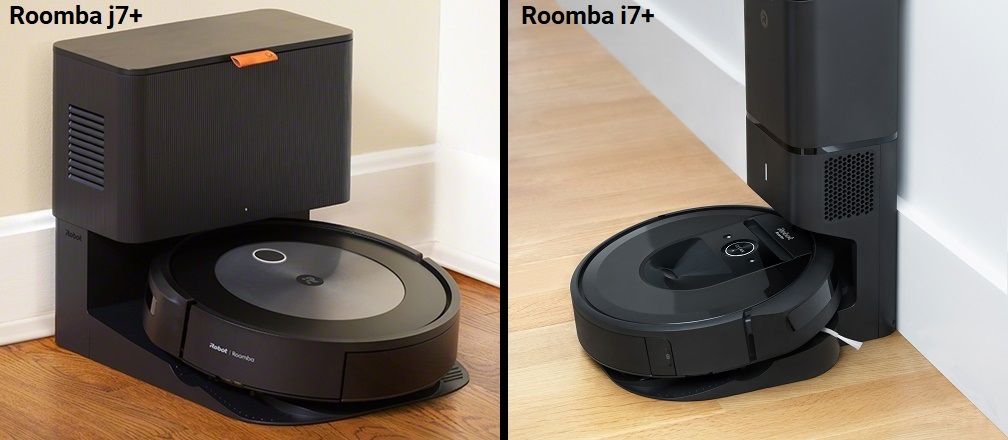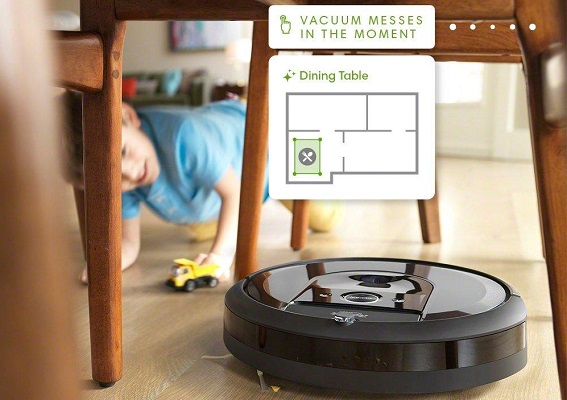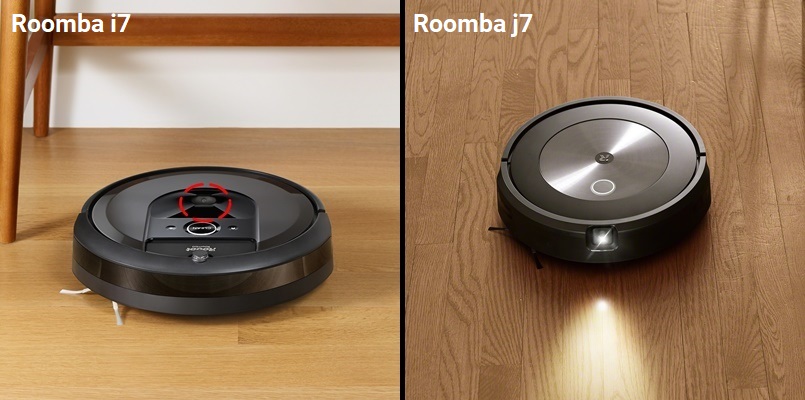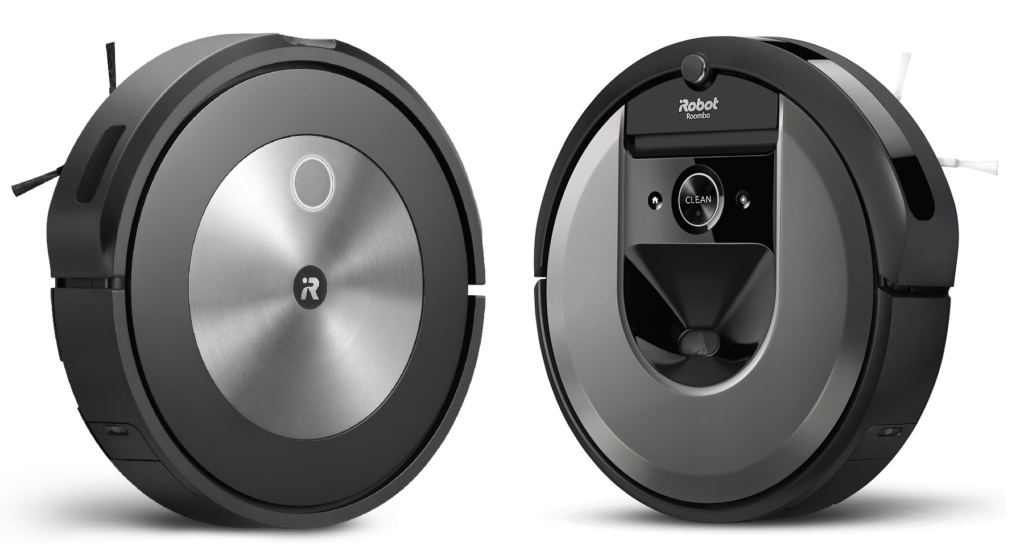In a nutshell, what are the differences between Roomba j7 and i7?
The main difference between the Roomba j7 and i7 is that the j7 has a front-facing camera which allows it to avoid obstacles, whereas the Roomba i7 has a top-mounted camera and no obstacle avoidance. The other difference only applies to the “plus” versions of these vacuums: the j7+ has a smaller auto-emptying home base while the i7+ sports the older, bulkier version.
For a deeper look at the two robot vacuums, keep reading below.
Contents
- 1 In a nutshell, what are the differences between Roomba j7 and i7?
- 2 Difference 1: The Roomba j7 has a front-facing camera for obstacle avoidance, the i7 has a top-mounted camera and no obstacle avoidance.
- 3 Difference 2: The Roomba j7 can send you a picture of new obstacles to learn how it should deal with them in the future.
- 4 Difference 3: The auto-emptying versions of these robots come with different bases.
- 5 Similarity 1: Both the I7 and J7 have smart navigation and will learn the layout of your home over time.
- 6 Similarity 2: Both have recharge and resume
- 7 Similarity 3: Both can be instructed to clean a specific room
- 8 Similarity 4: Both have the “keep out zones” feature.
- 9 What about the differences between Roomba j7+ and i7+?
- 10 Which one should you Pick?
When it comes to robot vacuums, Roombas are unmatched in terms of quality and dependability. But with so many different models available on the market, it can be pretty daunting to pick the right one for you. If you’re trying to choose between the Roomba j7 and i7, you’re in the right place. Both are quite capable vacuums with enticing features. This article will give you an unbiased comparison of the Roomba j7 vs i7 so you can make an informed decision.
Side note: whose idea was it to pick two letters whose lower case look so similar? Anyway, let us take a closer look at each difference.
Difference 1: The Roomba j7 has a front-facing camera for obstacle avoidance, the i7 has a top-mounted camera and no obstacle avoidance.
You have probably read stories of the poopocalypse, an event you will definitely want to avoid if you’re a pet owner. The Roomba j7 tries to avoid such a catastrophe by using its front-facing camera to continuously scan and analyze anything in its way. Plastic toy? No problem, I’ll push it out of the way. Potential fecal matter? Avoid at all costs.
The i7 does not have this feature. It has a top-mounted camera that’s able to map your house, but a camera on top does not allow it to avoid objects on the floor. To navigate around your furniture, the i7 relies on its bump sensor to gently collide with obstacles, then turn away. As you can probably imagine, this will not work with pet droppings.
The choice comes down to whether you have indoor pets or not. The lack of obstacle avoidance on the i7 is not a problem for households without pets. You can save a bunch of money by opting for the less expensive i7.
Or click here to see the Roomba j7+ on Amazon.
Difference 2: The Roomba j7 can send you a picture of new obstacles to learn how it should deal with them in the future.
The j7 adapts and learns on the fly. When it encounters a foreign object while cleaning, it will send pictures of the object to you via the iRobot app so you can decide what to do with it in the future. If the object is “hazardous”, it will continue to avoid it in the future. If not, it’ll know it’s safe to push it out of the way next time.
Difference 3: The auto-emptying versions of these robots come with different bases.

The i7 and j7 both have a “plus” version that comes with an auto-emptying docking station called the home base. The home base of the j7+ employs a newer, space-saving design, whereas the i7+ has the first-generation, bulkier design.
If you’ve ever seen the i7+’s home base in person, you know it’s quite tall and bulky. It might be hard to find a corner of your house to stow the home base if you live in a smaller house. The newer design of the j7+’s home base is shorter, giving you the ability to store it in more places than the i7+.
They use the same disposal bags, so the two different home bases hold the same amount of debris. In other words, you won’t have to empty the j7+’s disposal bag more often just because its docking station is smaller.
Now let’s take a look at their similarities.
Or click here to see the Roomba i7+ on Amazon.
The Roomba j7 and i7 both use their cameras and floor sensors to map your house so they can clean in a linear and efficient manner. Both of these vacuums will learn the layout of your house over time and learn where they are most likely to encounter dirt and use that information to focus on the areas that need it most.
The main difference between these two robots is their cameras: the Roomba j7 has a front-facing camera, whereas the Roomba i7 does not and relies solely on its front and top-mounted sensors for navigation.
Similarity 2: Both have recharge and resume
Both the Roomba j7 and i7 have “recharge and resume”, which means the Roomba will return to its home base to recharge when it senses that it won’t be able to finish cleaning your entire floor with its remaining battery.
Once it has enough power, it will return to where it left off in the cleaning cycle and continue on its way. This is a time-saver in most situations because you don’t have to worry about babysitting your robot while it cleans.
This feature is ideal if you have a particularly large home, or if you don’t run your robot vacuum frequently.
Similarity 3: Both can be instructed to clean a specific room

Because they are capable of learning your layout, both the Roomba J7 and I7 can be instructed to clean a specific room of your house.
You can assign names like “kitchen” or “dad’s office” to your rooms. You can even use a voice assistant like Siri or Alexa to command the Roomba. The process of initiating a clean is simple when you can just say “Alexa, tell Roomba to clean the kitchen”.
Similarity 4: Both have the “keep out zones” feature.
Keep out zones lets you designate a specific area of the floor as off-limits to your Roomba. This can be a particular room or a section of the house where your cat likes to sleep. The Roomba will recognize this area as forbidden and won’t go near it during cleaning cycles.
What about the differences between Roomba j7+ and i7+?

The exact same differences apply: They both have smart navigation, recharge and resume, and can be instructed to clean a specific room. The main difference is that the j7+ has a front-facing camera for obstacle avoidance, whereas the i7+ does not. The other difference is that the j7+ comes with a smaller, less bulky home base than i7+.
Note that the regular i7 and j7 come with a standard charging dock instead of a homebase, whereas the i7+ and j7+ come with an auto-emptying docking station.
The auto-emptying base is what the “plus” refers to. For example, the Roomba j7+ is the Roomba j7 PLUS an auto-emptying home base.
Or click here to see the Roomba i7+ on Amazon.
Which one should you Pick?
The Roomba j7 has one major advantage over the Roomba i7: object identification. This is a huge deal for pet-owners, but barely makes a difference for those without pets.
If you’ve got pets, the decision is easy to make: pick up a Roomba j7. If you don’t own any pets, the choice mostly comes down to the price. Either vacuum will do. If at the time of reading this, the Roomba i7 is cheaper, it might be good enough for you. If the two vacuums are similarly priced though, I’d opt for the j7 since it has that front facing camera.
Both will vacuum your house well, but one is able to dodge poop and the other one isn’t.
Which one will you choose? Let us know in the comments below.
Or click here to see the Roomba j7+ on Amazon.


I have rugs with dark brown designs on them. Before the j7, the other roombas would stop as if going down the stairs. I had to cover the sensors to get the rugs cleaned by a Roomba. The j7 has no problem with these rugs.
Thanks for sharing your experience with us, DD.
Good to hear that the j7 does not have issues with dark rugs for you.
I’m sure other readers with dark rugs will find this information very helpful.
Both j7 and i7 can run on dark carpet.
Thank you! Very helpful!
Excellent article! What I’m missing is height comparison: My i7 keeps getting bumped and stuck below our sleeping bed, so I’m considering changing to the j7 or maybe even the S9.